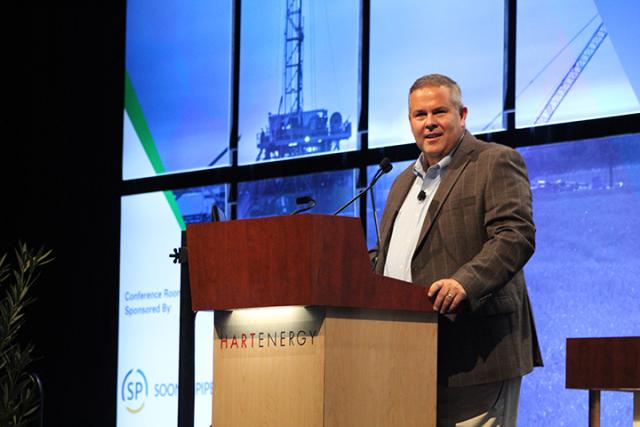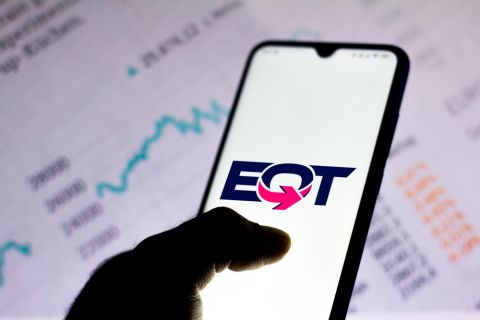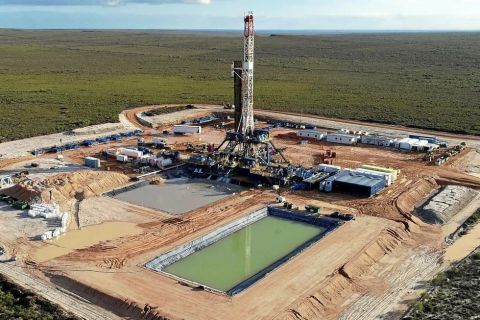
Jay Graham, CEO, Spur Energy Partners discusses his company's Permian Basin deal in the Northwest Shelf at the Executive Oil Conference in Midland. (Source: Emily Patsy, Hart Energy)
MIDLAND, Texas—“It’s a tough time right now” in the oil and gas business but deals can and do get done with perseverance, according to Jay Graham, CEO of Houston-based Spur Energy Partners.
Graham made his comments in a keynote at Hart Energy’s recent Executive Oil Conference, describing multiple transactions he has been involved in over the years, adding the deal that put together Spur’s acreage in the Permian Basin’s Northwest Shelf “was the hardest dang thing we’ve ever done.” He noted his previous work with the Wild Horse group involved more than $10 billion in deals.
Spur Energy is a private company focused on “acquiring and operating cash flowing E&P assets with long-term growth potential,” he said. Spur has deployed more than $1 billion of capital in the Yeso Trend in southeastern New Mexico with support from private-equity partners Kohlberg Kravis Roberts & Co. and The Energy and Minerals Group, “in a unique structure.
“We’re kind of out of the build-and-flip,” Graham added. “We’re holding this and we’re holding it forever. That’s a very different private equity structure. Not to give away our secrets on how incentives work, but you’ve got to get a little creative to be able to incentivize staff and incentivize entrepreneurs because we like change. We like to do things differently... We’ve got to go into this with a very long-term view and we’ve worked that out with our investors on our long-term view.”
Spur sought to come into the Northwest Shelf “and champion the area” to, appropriately, spur its development, Graham said. That came through some $1.3 billion in private equity that put the operation together.
Spur has production of 34,000 barrels of oil equivalent per day, 81% liquids, from more than 3,000 wells located on 94,000 net acres. Graham said estimated 2020 EBITDA is projected at $240 million. A one-rig drilling program generates substantial free cash flow.
The acreage includes six stacked-play landing zones in the Yeso formation. Some 60% of the acreage lies on federal lands, 30% state land and 10% fee. He admitted the federal acreage causes concern, “we all know what’s going to happen a year from now” and, given talk by some presidential candidates to ban hydraulic fracturing on government-held acreage, the election could have a significant impact on Spur. But if that happens, Graham said the public outcry over soaring energy costs could make such a prohibition short lived.
“We still don’t know how to drive on pixie dust,” he added.
“We have ample infrastructure in place to support development,” he added, including 250 miles of pipeline and 58 disposal wells. Most of the crude sells to Holly Frontier’s nearby Navajo refinery in Artesia, N.M.
Graham noted environmental, social and governance (ESG) initiatives “are cool now” in the oil and gas business “but it’s always been a big thing for us.” He described how his previous firms were active in community support programs in Louisiana and East Texas. He said Spur has taken similar action to support the community in and around its New Mexico holdings.
Recommended Reading
Matador Resources Announces Quarterly Cash Dividend
2024-04-18 - Matador Resources’ dividend is payable on June 7 to shareholders of record by May 17.
EQT Declares Quarterly Dividend
2024-04-18 - EQT Corp.’s dividend is payable June 1 to shareholders of record by May 8.
Scotland Ditches 2030 Climate Target to Cut Emissions by 75%
2024-04-18 - Scotland was constrained by cuts to the capital funding it receives from the British government and an overall weakening of climate ambition by British Prime Minister Rishi Sunak, said Mairi McAllan, the net zero secretary for Scotland's devolved government.
Iraq to Seek Bids for Oil, Gas Contracts April 27
2024-04-18 - Iraq will auction 30 new oil and gas projects in two licensing rounds distributed across the country.
Triangle Energy, JV Set to Drill in North Perth Basin
2024-04-18 - The Booth-1 prospect is planned to be the first well in the joint venture’s —Triangle Energy, Strike Energy and New Zealand Oil and Gas — upcoming drilling campaign.



